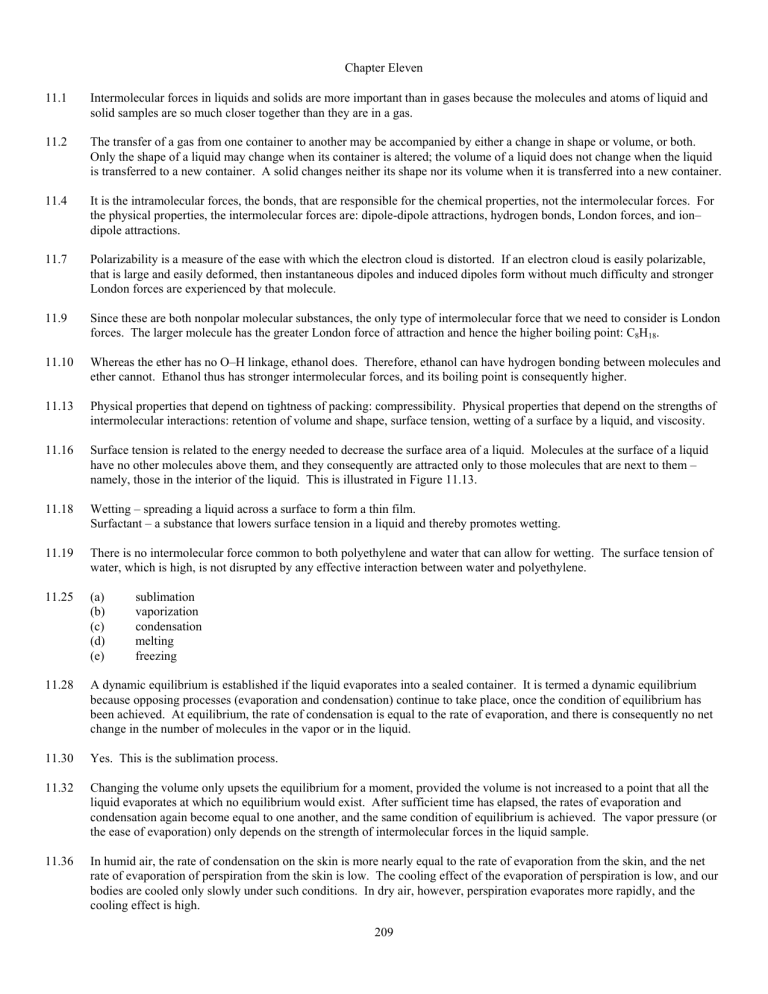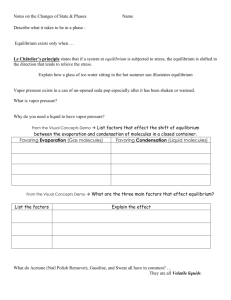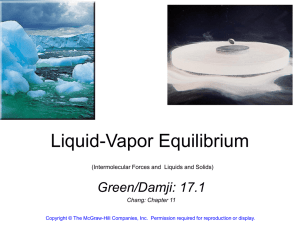chp 11 wiley
advertisement

Chapter Eleven 11.1 Intermolecular forces in liquids and solids are more important than in gases because the molecules and atoms of liquid and solid samples are so much closer together than they are in a gas. 11.2 The transfer of a gas from one container to another may be accompanied by either a change in shape or volume, or both. Only the shape of a liquid may change when its container is altered; the volume of a liquid does not change when the liquid is transferred to a new container. A solid changes neither its shape nor its volume when it is transferred into a new container. 11.4 It is the intramolecular forces, the bonds, that are responsible for the chemical properties, not the intermolecular forces. For the physical properties, the intermolecular forces are: dipole-dipole attractions, hydrogen bonds, London forces, and ion– dipole attractions. 11.7 Polarizability is a measure of the ease with which the electron cloud is distorted. If an electron cloud is easily polarizable, that is large and easily deformed, then instantaneous dipoles and induced dipoles form without much difficulty and stronger London forces are experienced by that molecule. 11.9 Since these are both nonpolar molecular substances, the only type of intermolecular force that we need to consider is London forces. The larger molecule has the greater London force of attraction and hence the higher boiling point: C8H18. 11.10 Whereas the ether has no O–H linkage, ethanol does. Therefore, ethanol can have hydrogen bonding between molecules and ether cannot. Ethanol thus has stronger intermolecular forces, and its boiling point is consequently higher. 11.13 Physical properties that depend on tightness of packing: compressibility. Physical properties that depend on the strengths of intermolecular interactions: retention of volume and shape, surface tension, wetting of a surface by a liquid, and viscosity. 11.16 Surface tension is related to the energy needed to decrease the surface area of a liquid. Molecules at the surface of a liquid have no other molecules above them, and they consequently are attracted only to those molecules that are next to them – namely, those in the interior of the liquid. This is illustrated in Figure 11.13. 11.18 Wetting – spreading a liquid across a surface to form a thin film. Surfactant – a substance that lowers surface tension in a liquid and thereby promotes wetting. 11.19 There is no intermolecular force common to both polyethylene and water that can allow for wetting. The surface tension of water, which is high, is not disrupted by any effective interaction between water and polyethylene. 11.25 (a) (b) (c) (d) (e) 11.28 A dynamic equilibrium is established if the liquid evaporates into a sealed container. It is termed a dynamic equilibrium because opposing processes (evaporation and condensation) continue to take place, once the condition of equilibrium has been achieved. At equilibrium, the rate of condensation is equal to the rate of evaporation, and there is consequently no net change in the number of molecules in the vapor or in the liquid. 11.30 Yes. This is the sublimation process. 11.32 Changing the volume only upsets the equilibrium for a moment, provided the volume is not increased to a point that all the liquid evaporates at which no equilibrium would exist. After sufficient time has elapsed, the rates of evaporation and condensation again become equal to one another, and the same condition of equilibrium is achieved. The vapor pressure (or the ease of evaporation) only depends on the strength of intermolecular forces in the liquid sample. 11.36 In humid air, the rate of condensation on the skin is more nearly equal to the rate of evaporation from the skin, and the net rate of evaporation of perspiration from the skin is low. The cooling effect of the evaporation of perspiration is low, and our bodies are cooled only slowly under such conditions. In dry air, however, perspiration evaporates more rapidly, and the cooling effect is high. sublimation vaporization condensation melting freezing 209 Chapter Eleven 11.39 At about 77 °C 11.42 Inside the lighter, the liquid butane is in equilibrium with its vapor, which exerts a pressure somewhat above normal atmospheric pressure. This keeps the butane as a liquid. 11.43 Since H2Se is larger than H2S, its London forces are stronger than in H2S. Because water is capable of hydrogen bonding, whereas H2S is not, its boiling point is higher than that of H2S. 11.54 This is an endothermic system, and adding heat to the system will shift the position of the equilibrium to the right, producing a new equilibrium mixture having more liquid and less solid. Some of the solid melts when heat is added to the system. 11.55 Changing the temperature disrupts the sublimation, deposition equilibrium that was established. By lowering the temperature, the kinetic energy of the molecules will decrease and more deposition will occur, giving rise to a lower vapor pressure. This will continue until a new equilibrium is established in which the rate of sublimation and deposition are again equal. 11.73 Critical temperature – the temperature above which the substance can not exist as a liquid, regardless of the applied pressure. It is, therefore, the temperature above which a gas cannot be made to liquefy, regardless of the amount of pressure that is applied. Critical pressure – the vapor pressure of a liquid at the liquid's critical temperature. A critical temperature and critical pressure together constitute a substance's critical point. 11.75 Solid, liquid and gas are all in equilibrium at the triple point. 11.76 Carbon dioxide does not have a normal boiling point because its triple point lies above one atmosphere. Thus, the liquid– vapor equilibrium that is taken to represent the boiling point does not exist at the pressure (1 atm) conventionally used to designate the "normal" boiling point. 11.78 Diethyl ether has the faster rate of vaporization, since it does not have hydrogen bonds, as does butanol. 11.81 (a) (b) (c) (d) 11.87 diethyl ether < ethanol < water < ethylene glycol London forces, dipole-diploe, H-bonding London forces, dipole-dipole London forces London forces, dipole-dipole, H-bonding 11.108 P (atm) 1.0 0.30 -15.0 -10.0 90 T (° C) 11.110 (a) solid (b) gas (c) liquid (d) solid, liquid, and gas 210



